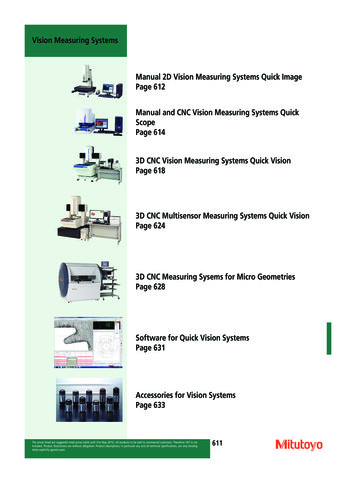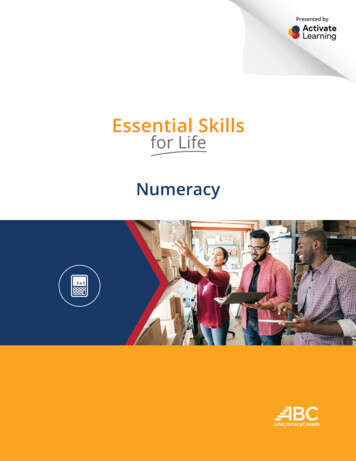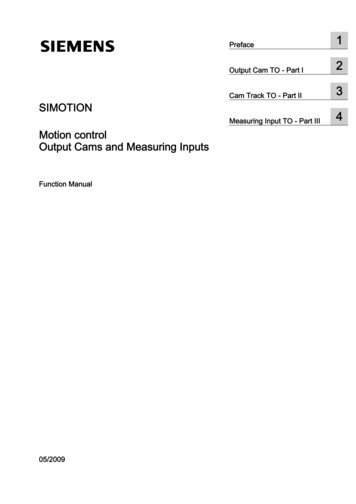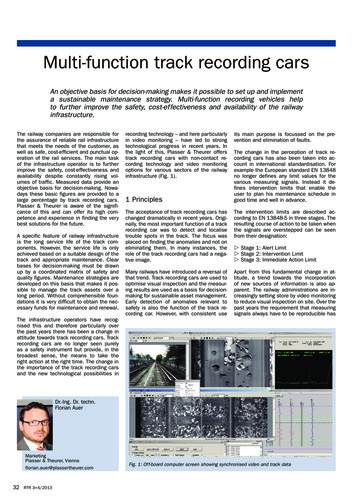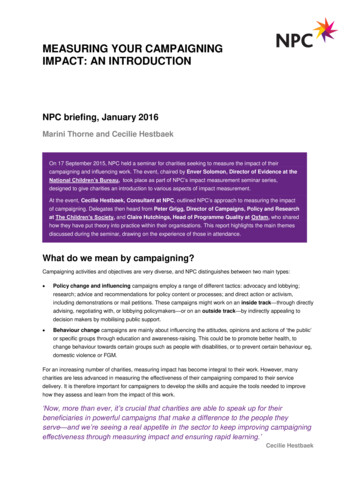
Transcription
MEASURING YOUR CAMPAIGNINGIMPACT: AN INTRODUCTIONNPC briefing, January 2016Marini Thorne and Cecilie HestbaekOn 17 September 2015, NPC held a seminar for charities seeking to measure the impact of theircampaigning and influencing work. The event, chaired by Enver Solomon, Director of Evidence at theNational Children’s Bureau, took place as part of NPC’s impact measurement seminar series,designed to give charities an introduction to various aspects of impact measurement.At the event, Cecilie Hestbaek, Consultant at NPC, outlined NPC’s approach to measuring the impactof campaigning. Delegates then heard from Peter Grigg, Director of Campaigns, Policy and Researchat The Children’s Society, and Claire Hutchings, Head of Programme Quality at Oxfam, who sharedhow they have put theory into practice within their organisations. This report highlights the main themesdiscussed during the seminar, drawing on the experience of those in attendance.What do we mean by campaigning?Campaigning activities and objectives are very diverse, and NPC distinguishes between two main types: Policy change and influencing campaigns employ a range of different tactics: advocacy and lobbying;research; advice and recommendations for policy content or processes; and direct action or activism,including demonstrations or mail petitions. These campaigns might work on an inside track—through directlyadvising, negotiating with, or lobbying policymakers—or on an outside track—by indirectly appealing todecision makers by mobilising public support. Behaviour change campaigns are mainly about influencing the attitudes, opinions and actions of ‘the public’or specific groups through education and awareness-raising. This could be to promote better health, tochange behaviour towards certain groups such as people with disabilities, or to prevent certain behaviour eg,domestic violence or FGM.For an increasing number of charities, measuring impact has become integral to their work. However, manycharities are less advanced in measuring the effectiveness of their campaigning compared to their servicedelivery. It is therefore important for campaigners to develop the skills and acquire the tools needed to improvehow they assess and learn from the impact of this work.‘Now, more than ever, it’s crucial that charities are able to speak up for theirbeneficiaries in powerful campaigns that make a difference to the people theyserve—and we’re seeing a real appetite in the sector to keep improving campaigningeffectiveness through measuring impact and ensuring rapid learning.’Cecilie HestbaekNPC – Transforming the charity sector
Measuring your campaigning impact: An introductionWhy measure the impact of campaigning?‘It is incumbent upon the voluntary sector to hold a mirror up to ourselves and toquestion whether we are making a difference through lobbying and campaigning.’Enver Solomon, National Children’s BureauGood measurement and evaluation will allow you to monitor whether or not your campaign is helping you achieveyour charity’s objectives, bringing advantages that include: Learning on the job: Campaigns are often complex and long-running, involving a range of tactics that aredelivered in parallel. Effectiveness may therefore be subject to changes in the external environment, whichbecome especially pronounced over the longer term. Continual assessment helps bring clarity—particularly ifyou use an evaluation framework—which will help you proceed in a more structured and evidence-basedway. Showing accountability to stakeholders: If you can explain the causal links between your tactics and thesocial change you hope to bring about—and report on your progress—members, staff and those you arecampaigning on behalf of will find it easier to understand the bigger picture of how your campaigning effortsbring about change, helping ensure stakeholder support. It also allows you to evidence that you are adhering1to charity regulation . Appealing to funders: Demonstrating how your campaigning work has contributed to change can help youattract funding, and will also make it easier for funders to monitor their own impact.Getting started: How to measure the impact of your campaignsStructure and planning is key to measurementFigure 1. NPC’s four pillar approach2success.NPC's four pillar approach is a usefulframework that can help you measure the impact of yourcampaigning and influencing work. This simple step-bystep process allows organisations of any size or type tostart thinking about their social impact.The approach comprise of four steps:31.Map your theory of change2.Prioritise what you measure3.Choose your level of evidence4.Select your sources and toolsStep one: Map your theory of changeIt can be hard to know where to start when measuring the impact of a campaign. With a theory of change you cantrack the progress you make towards your final goal by setting a series of intermediate goals. If the causal linksbetween intermediate and final outcomes are well evidenced and you can show improvements to intermediateoutcomes then it is reasonable to expect the final outcomes will occur.1Namely the Transparency of Lobbying, Non-Party Campaigning and Trade Union Administration Act and the CharityCommission’s CC9 guidance.2Kazimirski, A. and Pritchard, D. (2014) NPC’s four pillar approach. New Philanthropy Capital.3See Harries, E., Noble, J. and Hodgson, L. (2014) Creating your theory of change: NPC’s practical guide. New PhilanthropyCapital.2
Measuring your campaigning impact: An introductionStep two: Prioritise what you measureIrrespective of whether your campaign is large orFigure 2. Examples of intermediate outcomessmall, you need to ask yourself which intermediateoutcomes are the most essential and meaningful tomeasure. It is important to prioritise those that: you will directly influence; are important to your campaign’s mission; are not too costly to measure; and will produce credible data.Case Study: Claire Hutchings, Oxfam GBWhat?Oxfam’s campaigning and advocacy work is a major part of their activities and centres on three keythemes: poverty and inequality; food and climate change; and conflict and emergencies. The charitybegan monitoring and evaluating their campaigns in 2008.Why?Oxfam noticed shifts in the external and internal environment—an increasingly sceptical public, agovernment needing to justify aid spending, and increased pressure from donors to demonstrate the‘value’ of their activities.The charity’s diverse portfolio of campaigning methods has meant that different campaigns have beenrun in different ways with very different results. Improving standards of evaluation has therefore helpedOxfam to better reflect on their programmes and determine how best to improve.Oxfam were also keen to better capture their effectiveness in a way that could be aggregated andcompared across different contexts and countries.How?Oxfam tends to use process tracing. This method aims to reconstruct the course of events leading up to acertain outcome or number of outcomes, taking into account the different factors which may haveinfluenced the results.LessonsFrom their experience so far, Oxfam have learned the following about the evaluation process: Theories of change are rarely explicit and often take some time to work out or adjust. Regularlyreviewing your plan or theory of change is crucial. Evaluating the ‘right’ outcomes is very important—they serve as an important indicator as to whetheror not campaigns have reached a ‘tipping point’. The process tracing method is most effective when applied to a decision making process whichoccurs in the public realm, such as public lobbying or campaigning. It works less well at measuringthe impact of a campaign on an organisation, behaviour change campaigns, or empowermentcampaigns.3
Measuring your campaigning impact: An introductionStep three: Choose your level of evidenceThe results of campaigning activities can be harder to pin down than those of service delivery. You need tochoose a level of evidence that is proportionate to the size of your campaign and for which you can realisticallycollect data.Different types of evidence and their uses for understanding the impact of your campaigning and influencing workcan be split broadly into two areas: Tracking the extent to which the change has happened. Quantitative methods can help you establishwhether your campaign is or is not successful. They may help to establish, for example, how many saw thecampaign material. It can also tell you how many people changed their attitudes, acted in a specific way, orvoted for a certain policy as a result of the campaign. Tracking how the change happened. Qualitative methods can help you explain why your campaign was orwas not successful. They may help you understand what the intended audience thought of your campaign,whether or not the campaign material made a difference to them and if so how.Step four: Select your sources and toolsOnce you have decided what you need to measure, and the level of evidence you intend to collect, it is crucial toidentify the right tools for the job. Below are some tools commonly used to measure the influence of campaigning.Type of dataMethod of collectionQuantitativeSurveys/questionnaires can be targeted to the right population and customised around theoutcomes you want to measure.Psychometric scales are a type of short questionnaire, designed by psychologists andsociologists. They measure subjective feelings, beliefs and attitudes, eg, self-esteem or empathy.Quantitative content analysis allows you to investigate the extent of linguistic changes withinselected channels such as media, speeches or policy documents eg, the uptake of certainlanguage such as ‘female genital mutilation’ instead of ‘female circumcision’.QualitativeInterviews with key stakeholders, influencers or informants help you understand the complexitiesof how and why change has occurred.Focus groups can be very useful for exploring why a campaign is or is not leading to change.Here, questions about thoughts, attitudes and beliefs towards a topic of interest are posed to agroup, who share their thoughts in an interactive manner.Anecdotes and feedback are a useful source and can be fairly straightforward to obtain. Keep animpact or evidence log (ie, an excel spreadsheet) in which you register both formal and informalfeedback on your work and results.Social network analysis is an analytical tool for studying relationships between stakeholders. It isparticularly helpful for policy influence work, as it can help you to understand how formal andinformal relationships work, and monitor the changes in these along with structures of networks.Process tracing applies mainly to policy influence work and uses interviews, along with qualitativeanalysis of documents, to trace policy ideas from inception to political salience and all the way toimplementation.Ethnography involves the systematic observation and recording of behaviours of people in theirenvironment. This can be useful in recording information about behaviour that is otherwise difficultto obtain.4
Measuring your campaigning impact: An introductionCase Study: Peter Grigg, The Children’s SocietyWhat?The Children’s Society is a national charity that runs local projects for vulnerable children and young people. Italso campaigns to change laws that lead to children suffering from poverty and neglect.The charity is halfway through a five-year journey to better impact measurement. One aspect of this is evaluatingthe success of its work campaigning to improve the lives of vulnerable children.Why?In recent years, The Children’s Society has noticed an increase in external demand for its activities and thisrequires enhanced governance, systems and processes. Furthermore, the need to communicate internally andexternally about the charity’s work, and a desire to be a ‘learning organisation’, encouraged the staff to thinkabout how and why their campaigns are effective. The aim of doing so was to: capture the attention of the right audiences for their campaigns; deliver understandable and clear messages; influence beliefs or understanding; ensure a credible and robust evidence base for whether or not their campaigns work and why; and support the creation of social contexts that lead to desired outcomes.How?The Children’s Society goes through a number of steps when evaluating its campaigning. During the planningstages, the staff map out clear outputs, outcomes, and indicators of success within a theory of change. They thenemploy various evaluation elements including: monitoring outputs and outcomes; interviews with internal andexternal stakeholders; and discussions with coalition partners. They seek feedback from all partners includingthose who may have been hostile to the campaign’s focus.LessonsThe Children’s Society is conscious that impact evaluation is difficult—the lives of vulnerable children arecomplex, and so is policy change—so it works to ensure evaluation efforts are relevant and proportionate. It hasnow developed a standard evaluation framework that it can apply to all campaigns to make comparisons.Top tips for measuring the impact of your influencing workSpend time and effort on planningThis could involve properly developing your theory of change. Ask yourself: Does your plan make sense? Is itrealistic? Do you have the necessary resources to carry out (and evaluate) the campaign? Or does your focusneed to shift in order to get most out of your resources?Use what you already haveThink about the information your organisation already collects, and how that might help inform the evaluation ofyour campaign. This could include media hits, meetings held with policymakers, twitter engagement levels andwebsite visits.Be proportionateEnsure you are prioritising measurement for the most important outcomes. Your campaign may result in a numberof outcomes—intended or otherwise—but impact measurement must be proportionate, so focus on what is5
Measuring your campaigning impact: An introductioninstrumental to your work. Similarly, do not feel you have to collect all of the required measurement data yourself.You may be able to obtain the information you need elsewhere eg, from government data or academic research.Focus on learningLearning and improving is a key reason that charities should be seeking to measure the impact of their work, andcampaigns are no exception. A good way to do this is to have a thorough debrief with your team in which you canthoroughly scrutinise the results. Think about what your results show, what went well and what didn’t, and whatyou will change next time.Differentiate between contribution and attributionMost campaign successes happen because all the pieces in a large puzzle come together. For example,legislative change may occur as the result of your campaigning, but it is most likely that it was also brought aboutby a combination of shifting political factors, changing public opinion, and external events. You may not be able toattribute this change to your campaign, but you need to at least be clear on what your contribution was,whether that was influencing the media, mobilising specific groups, or building a wider coalition.Final thoughtsMeasuring the impact of influencing, advocacy, or behaviour change campaigns can seem endlessly complex, butwith the right step-by-step approach it can be achieved even while you carry out your campaign—with hugebenefits for your organisation’s learning and effectiveness. As the case studies here hope to reflect, there is goodreason for charities to measure the impact of their campaigning work. It is a difficult but rewarding process, andwith the right tools and knowledge it is possible.More in this seriesThis guide is part of a series developed from NPC seminars to give an introduction to various aspects ofimpact measurement. Other topics in this series include:Keeping it in proportion: Impact measurement for small charitiesStories and numbers: Collecting the right impact dataResult! What good impact reporting looks likeWe will soon have new dates and topics for our measurement seminars in 2016, so check theevents section of our website for the latest information.Further resourcesHestbaek, C. (2014) Closing in on change: Measuring the effectiveness of your campaign. NewPhilanthropy Capital.Kazimirski, A. and Pritchard, D. (2014) NPC’s four pillar approach. New Philanthropy Capital.Lamb, B. (2011) Campaigning for change: Learning from the United States. NCVO.Inspiring Impact www.inspiringimpact.org6
TRANSFORMING THE CHARITY SECTORNPC is a charity think tank and consultancy which occupies a unique positionat the nexus between charities and funders, helping them achieve the greatestimpact. We are driven by the values and mission of the charity sector, to whichwe bring the rigour, clarity and analysis needed to better achieve the outcomeswe all seek. We also share the motivations and passion of funders, to which webring our expertise, experience and track record of success.Increasing the impact of charities: NPC exists to make charities and socialenterprises more successful in achieving their missions. Through rigorousanalysis, practical advice and innovative thinking, we make charities’ moneyand energy go further, and help them to achieve the greatest impact.Increasing the impact of funders: NPC’s role is to make funders moresuccessful too. We share the passion funders have for helping charities andchanging people’s lives. We understand their motivations and their objectives,and we know that giving is more rewarding if it achieves the greatest impact itcan.Strengthening the partnership between charities and funders: NPC’smission is also to bring the two sides of the funding equation together,improving understanding and enhancing their combined impact. We can helpfunders and those they fund to connect and transform the way they worktogether to achieve their vision.New Philanthropy Capital185 Park Street, London SE1 9BL020 7620 4850info@thinkNPC.orgRegistered charity No 1091450A company limited by guaranteeRegistered in England and Wales No 4244715www.thinkNPC.orgNPC – Transforming the charity sector
the impact of a campaign on an organisation, behaviour change campaigns, or empowerment campaigns. Measuring your campaigning impact: An introduction . and monitor the changes in these along with structures of networks. Process tracing applies mainly to policy influence work and uses interviews, .
